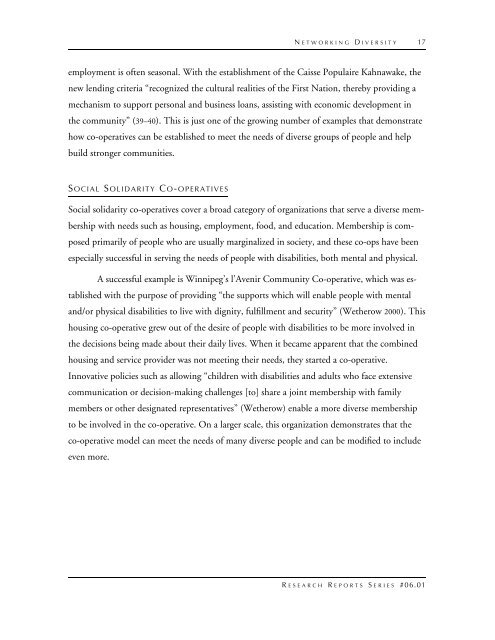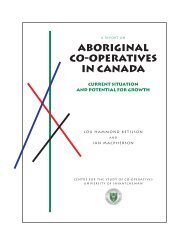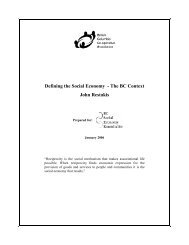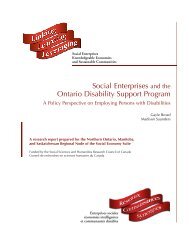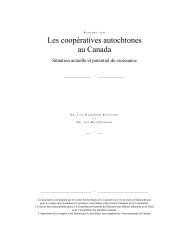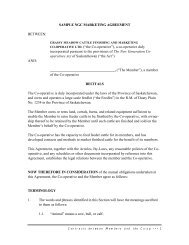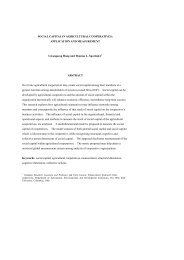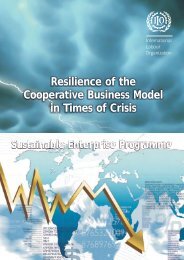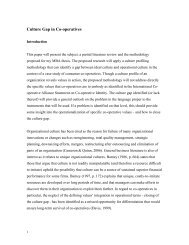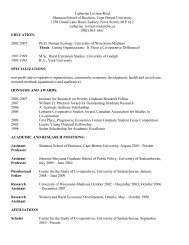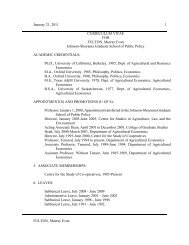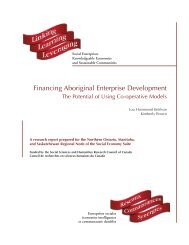Network Diversity - Centre for the Study of Co-operatives
Network Diversity - Centre for the Study of Co-operatives
Network Diversity - Centre for the Study of Co-operatives
You also want an ePaper? Increase the reach of your titles
YUMPU automatically turns print PDFs into web optimized ePapers that Google loves.
N E T W O R K I N G D I V E R S I T Y 17<br />
employment is <strong>of</strong>ten seasonal. With <strong>the</strong> establishment <strong>of</strong> <strong>the</strong> Caisse Populaire Kahnawake, <strong>the</strong><br />
new lending criteria “recognized <strong>the</strong> cultural realities <strong>of</strong> <strong>the</strong> First Nation, <strong>the</strong>reby providing a<br />
mechanism to support personal and business loans, assisting with economic development in<br />
<strong>the</strong> community” (39–40). This is just one <strong>of</strong> <strong>the</strong> growing number <strong>of</strong> examples that demonstrate<br />
how co-<strong>operatives</strong> can be established to meet <strong>the</strong> needs <strong>of</strong> diverse groups <strong>of</strong> people and help<br />
build stronger communities.<br />
S O C I A L S O L I D A R I T Y CO- O P E R A T I V E S<br />
Social solidarity co-<strong>operatives</strong> cover a broad category <strong>of</strong> organizations that serve a diverse membership<br />
with needs such as housing, employment, food, and education. Membership is composed<br />
primarily <strong>of</strong> people who are usually marginalized in society, and <strong>the</strong>se co-ops have been<br />
especially successful in serving <strong>the</strong> needs <strong>of</strong> people with disabilities, both mental and physical.<br />
A successful example is Winnipeg’s l’Avenir <strong>Co</strong>mmunity <strong>Co</strong>-operative, which was established<br />
with <strong>the</strong> purpose <strong>of</strong> providing “<strong>the</strong> supports which will enable people with mental<br />
and/or physical disabilities to live with dignity, fulfillment and security” (We<strong>the</strong>row 2000). This<br />
housing co-operative grew out <strong>of</strong> <strong>the</strong> desire <strong>of</strong> people with disabilities to be more involved in<br />
<strong>the</strong> decisions being made about <strong>the</strong>ir daily lives. When it became apparent that <strong>the</strong> combined<br />
housing and service provider was not meeting <strong>the</strong>ir needs, <strong>the</strong>y started a co-operative.<br />
Innovative policies such as allowing “children with disabilities and adults who face extensive<br />
communication or decision-making challenges [to] share a joint membership with family<br />
members or o<strong>the</strong>r designated representatives” (We<strong>the</strong>row) enable a more diverse membership<br />
to be involved in <strong>the</strong> co-operative. On a larger scale, this organization demonstrates that <strong>the</strong><br />
co-operative model can meet <strong>the</strong> needs <strong>of</strong> many diverse people and can be modified to include<br />
even more.<br />
R E S E A R C H R E P O R T S S E R I E S # 0 6 . 0 1


